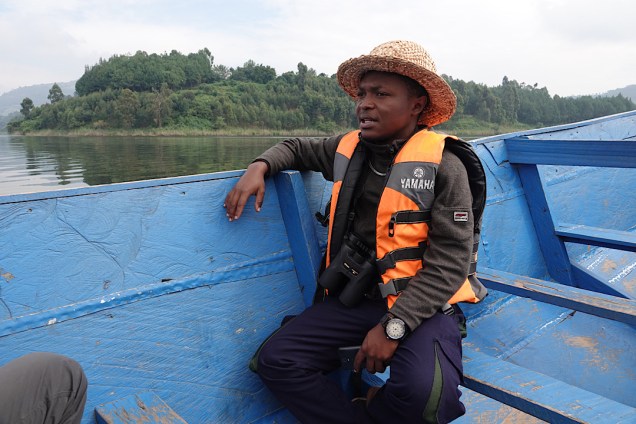
As I explained in my last post, Steve and I made this trek to Africa because of the Ugandan grannies. But after flying here via Qatar (and stopping there for three nights), the granny research consumed only four days. It seemed a shame to come halfway around the world, then turn around and go home after such a short time. Also, another adventure called to us.
Several years ago, Steve and I became aware of the plight of the bonobo (along with chimpanzees, Homo sapiens’ closest relative left on earth). There’s a bonobo sanctuary in the heart of Africa that is doing great work for this crucially important but highly threatened species. After visiting the grandmother project, Steve and I wanted to visit that sanctuary.
This isn’t easy. Lola Ya Bonobo (literally “Paradise for Bonobos”) is located outside the city of Kinshasa in the Democratic Republic of Congo. The second largest country in Africa, the DRC is also one of the most tragic. It’s ridiculously rich in resources, mineral and physical, yet it’s one of the poorest countries in the world, with one of the bloodiest histories. It does not welcome tourists. As far as I could make out, it has no tourist industry. To go there, someone has to invite you, the invitation has to be approved by multiple ministries in the Congolese capital, and you have to send your passport to the DRC’s embassy in Washington DC to receive the crucial stamp.
Transportation options are limited, but the Rwandan airline does fly to Kinshasa nonstop from the capital of Rwanda, Kigali. The flight is only two and a half hours long, and Rwandair has an excellent reputation. The only problem (for us) was that this flight only operates a couple of times of week. Steve and I couldn’t get to Kigali from Nyaka (the Ugandan village where the granny program is based) on Sunday, and the next nonstop wasn’t until Wednesday (i.e. tomorrow).
Happily what initially looked like an irritating delay turned out to be a pleasure. I learned that we could be driven from Nyaka to Kigali via the site of Uganda’s most beautiful lake, Lake Bunyonyi. We planned to hole up there for two nights, review the work we’d done in Nyaka, and write about it. But yesterday morning, we couldn’t resist spending a few hours in a boat on the lake.
For $20 a person, the hotel where we were staying arranged for a motorboat, a guy to drive it, and a soft-spoken 23-year-old guide named Rabson. Rabson looked very young, but he’s been guiding for about three years, and I quickly found him to be quick-witted, conscientious, and knowledgeable.
The morning had started off a little drizzly, but as we putted along, the sky cleared. Lake Bunyonyi is the deepest lake in Uganda, and it’s filled with 29 islands, most uninhabited. It has no dangerous animals like crocodiles or hippos, and almost no fish.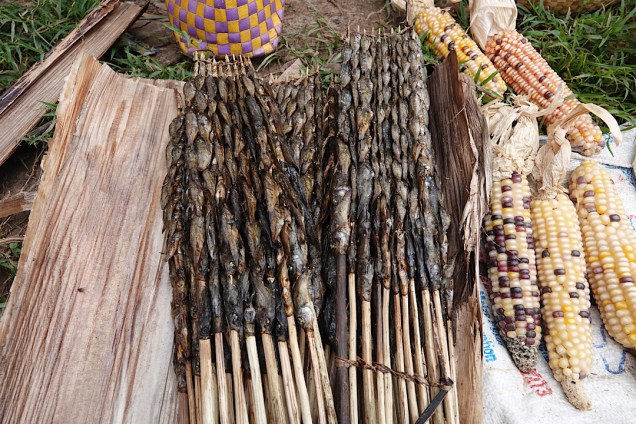
The islands create a landscape that reminded me a bit of the New Zealand fiordlands. But the steep hillsides surrounding the water are an intense tropical green, dotted with banana groves. People swim in the lake, and it provides drinking water to the local villagers.
Rabson loves birds, and he pointed out many interesting specimens to us, including these.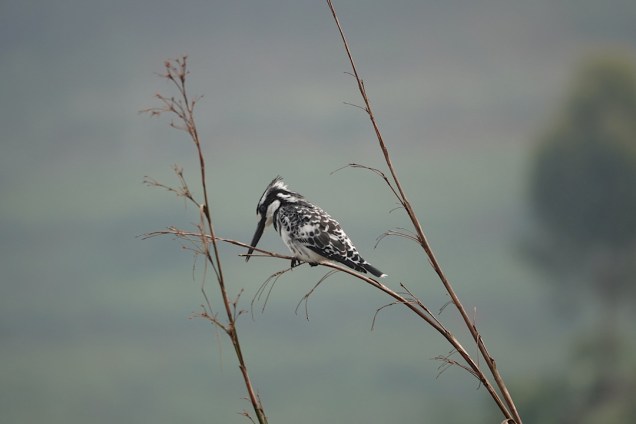
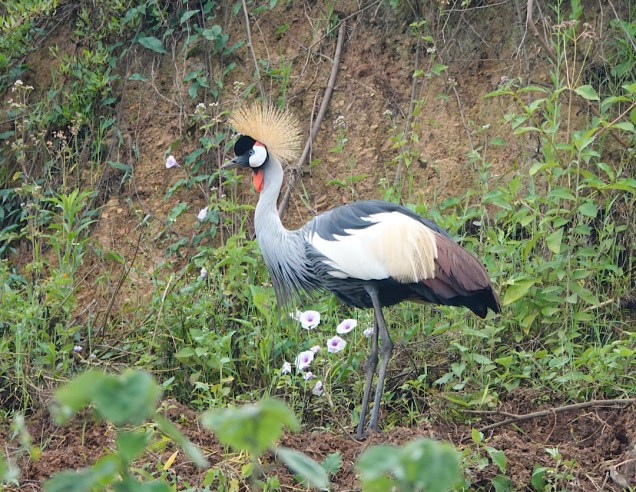
He recounted the history of some of the islands. Then he began talking about something that startled me: namely, how most kids in Uganda reach puberty without knowing anything about menstruation.
When girls suddenly begin to bleed, it shocks and horrifies their classmates. Girls have no access to sanitary pads, so they use torn-up t-shirts or leaves or other crude substitutes for sanitary pads that sometimes trigger infections. But Rabson had met someone who was trying to do something to change that and he wanted to take us to meet her.
Steve and I had seen so many African marketplaces over the past few days, I wasn’t dying to see another, but we held our tongues. We sensed it was important to Rabson to share this.
Our boatman pulled up to a dock on the mainland. We disembarked and walked into the jumble of stalls and food sellers that takes shape there every Monday and Friday. We followed Rabson up the dirt path to a compact wooden shack, where a friendly face beamed at us from a window, welcoming us. Rabson pointed out the poster on the front of the building, explaining the project, then his friend Harriet Rwosa stepped out and invited us inside.
We followed Rabson up the dirt path to a compact wooden shack, where a friendly face beamed at us from a window, welcoming us. Rabson pointed out the poster on the front of the building, explaining the project, then his friend Harriet Rwosa stepped out and invited us inside.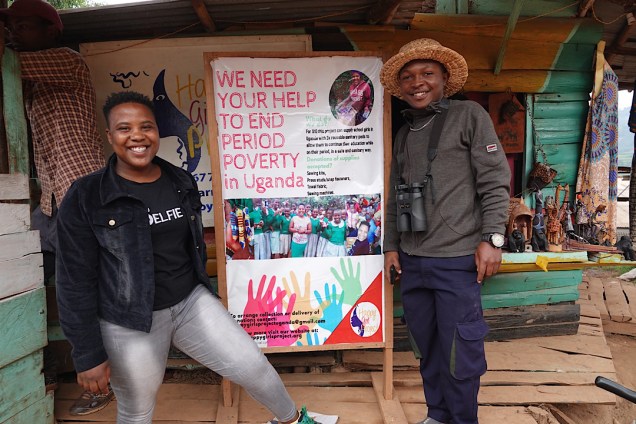
If someone told me Harriet was educated in England, I would have believed them; her English is excellent, an ebullient flood of words. But she’s lived all her life in this village. We learned that she’s 27 and married. But she only went through the local high school. Although she yearned to continue on at a university, her parents lacked the money to send her. Like most girls, in her school years Harriet had experienced menstruation as a curse. Every month it kept her out of class, causing her to to fall behind her male peers, a new experience for her. Time had passed, and somehow she’d gotten the idea to design and market cheap, reusable sanitary pads that would enable girls to continue their education, even while menstruating. About a year and a half ago, she’d made her first pads on a little foot-powered Singer sewing machine, and she had marshaled the funds to create a little craft shop to support the purchase of materials to make more pads. Some were lined with a soft toweling. For others Harriet uses a local fabric that resembles flannel. It costs more, she told us, but it’s also more absorbent.

For $10, you can buy 3 pads for a girl. I gave her $20.
As inspiring as Harriet was, I felt equally moved by Rabson, who believes in what Harriet is doing and is trying to help any way he can. As we walked back to the motorboat, he told us he had been bird-watching on one of the bigger islands when he happened to meet Harriet, there to pass out pads at the island high school. She told him about the project, and Rabson immediately understood its importance. One day when he was in the fifth grade of primary school, he had shared a bench with a 13-year-old girl. When she stood up at the end of class, blood stained her clothing and the bench. Today Rabson mimes the reaction of the other kids; their shock at the sight of this frightening blood. They jeered, hooted, cruelly mocked their classmate. She was so mortified and humiliated, she never came back to school. Rabson says not long after this incident, she was married and had a child, but her husband later left her. Her life was ruined for lack of a sanitary pad, something that Rabson still clearly finds appalling today.
He disapproves of giving out free condoms, without also handing out pads to girls. Having sex is something you choose, he declared. But you don’t have a choice about menstruating.
This is true. Hearing Ugandan 20-somethings testify to it, seeing some moved to action by it, inspired me and touched my heart. It made me wish I could return to make a documentary about passionate, energetic Harriet and the lives she’s already changing.
I almost certainly won’t have a chance to do that; it’s not my talent. But I’m grateful to be able to write about her here. I’m thrilled to be spending the night in a really nice hotel in central Kigali, overlooking the Hotel Mille Collines (the inspiration for the cinematic Hotel Rwanda.) I’m happy to have a good fast internet connection to publish this post. In just a few hours, we’ll take that flight to the Congo, where it’s unlikely we’ll have much in the way of WiFi or phone service. But I plan to write every day about our experience in the bonobo sanctuary, and I’ll post the results as soon as possible.
























